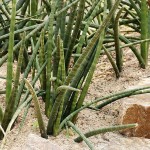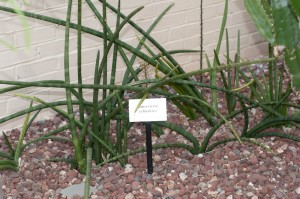Family: Asparagaceae
Synonymous: Acyntha cylindrica
Cordyline cylindrica
Sansevieria angolensis
Distribution and habitat: Sansevieria cylindrica is a succulent plant native to Angola. It is an evergreen perennial plant forming dense stands, spreading by creeping rhizome, which is sometimes above ground, sometimes underground. These plants in the wild frequently form diffuse colonies.
Description: Sansevieria cylindrica has striped, tubular leaves that are smooth and a green-gray colour with a dark-green striped pattern or just dark green colour in some cases. The leaves have pointed tips. A single leaf is about 3cm (1 inch) thick and grows to a height between 1 and 2m (3-7 feet). The Sansevieria cylindrica grows fan-shaped from underground rhizomes, its stiff leaves rising from a basal rosette. Plants are rigid, ribbed lengthwise and dark green cross-banded with grey-green when young. Long flower spikes may appear erratically on mature plants, arising from the base of the spears shaped leaves. The 3cm (1 inch) greenish-white tubular flowers are tinged with pink growing in clusters on an erect flower spike. Sansevieria cylindrica tends to bloom more readily from a young age than other varieties. These flowers are not particularly showy, but they are nicely fragrant. Occasionally flowers will be followed by spherical orange-red berries to about 1cm (0.4 inch) in diameter.
These interesting plants are one of the most unusual plants. The plant cylindrical spears that spring from the sandy soil can be braided or left in their natural fan shape. Best of all, they can be almost ignored and the plant will thrive.
Sansevieria cylindrica are extremely long lived plants.
Houseplant care: Sansevieria cylindrica is popular as an ornamental plant as it is easy to culture and take care of in a home. Truly, they thrive on neglect. One exception to this rule: their pots must be well drained.
Wipe the leaves with a damp cloth to keep them dust-free. Every leaf is tipped with narrow awl-shaped point and care should be taken not to damage it; a leaf with a broken tip will stop growing.
The growth is relatively slow and plants last for many years.
Light: Sansevieria cylindrica likes bright light and can stand plenty of direct sunlight. They will tolerate a certain amount of shade - at a slight shaded window - without detriment to their growth, but will virtually stop growing if they are forced to live in poor light for any length of time. But, they will survive in poor light.
When growing in high light, the leaves will grow more upright, desired look for a nice container plant.
Temperature: As native of the tropics, these plants thrive in average to warm room temperatures; from 18-26C (65-79F) suits them ideally. It will tolerate fluctuating temperatures, but never subject them to temperatures below 13C (55F).
Sansevieria cylindrica will tolerate dry air, but keep it away from air vents or drafts. Average room humidity will be satisfactory for this plant.
Watering: During the active growth period water only moderately, giving enough to make the potting mixture moist throughout at each watering, but allowing the top couple of centimetres of the potting mixture to dry out before watering again.
During the rest period allow at least half of the potting mixture to dry out between waterings. Overwatering leads to rot and cause the leaves to topple over at the point where they join the rootstock. Water the soil, taking care not to get water on the leaves, which will cause them to rot. If the leaves turn yellow or get soft and mushy at their base, the plant is overwatered. Empty the plant saucers after watering, to avoid that stagnant water to damage the roots.
The species is drought-tolerant and grown indoors it needs water only about once every other week during the active growing season.
Feeding: Do not over-fertilise these plants. Apply a liquid fertiliser about once a month to all plants during the active growth period, but only at half strength.
Potting and repotting: Repot in spring, only when plants get crowded and need dividing. Sansevieria cylindrica do not mind cramped root conditions and so can be left undisturbed for several years. Fleshy, usually cream-coloured roots will often appear on the surface of the potting mixture, but these plants do not really need repotting until they crack their pots. Ideally, the plants should be moved on shortly before reaching this stage, when the leaves occupy most of the pot surface. Keep the rosette of the leaves at soil level. Use a wide, heavy container to prevent toppling as this tall plant tend to be top-heavy. Repotting is best done in early spring.
In years when plants are not repotted, top-dress them with fresh potting mixture, first scraping away some of the loose old mixture carefully so as not to do any damage to the near surface roots.
For open, quick drainage add one-third coarse sand to a soil-based potting mixture and put plenty of clay-pot fragments or other drainage material into the bottom of the pot.
Gardening: Sansevieria cylindrica can be grown in the garden in mild to tropical climates and it is not fussy. When planting in ground space plants to allow clumps to form and develop properly. If planted too tightly there will not be enough room for root expansion and plants will not reach their full height and bloom potential.
In very cold zones a containerized Sansevieria can be brought inside for the winter months, when the temperatures drops below 13C (55F). Plants that have been living in the shade should not be moved to a sunny position without gradual acclimatization; sudden prolonged exposure to sunlight can result in leaf burn.
Position: It can be grown outdoors in partial shade. This plant needs only partial sunlight, avoiding midday direct sunshine which could cause unaesthetic burnings on the foliage.
Soil: Sansevieria cylindrica needs good drainage. Plant in ground in well drained, sandy soil enriched with peaty compost.
Irrigation: Sansevieria cylindrica only needs watering about once or twice a month during the warmer season and it should be kept drier in winter.
This plant is very drought resistant. Do not over-water it, especially in winter.
Fertilising: Mixing a small amount of slow time release fertiliser into the lower level of the soil before planting speeds up the rate of growth. However, fertiliser can be detrimental to Sansevieria cylindrica and too much can kill the plant. Use a cactus fertiliser or slow time release fertiliser once a month.
These plants are light feeders, however unfertilized they will tend to grow very slow. Do not overfertilise them. Always, less is better than too much fertiliser for these plants.
Propagation: Sansevieria cylindrica can be propagated by dividing up overcrowded clumps of leaves. Detach clusters of leaves from rootstock with a sharp knife when the leaves are 15cm (6 inch) long. Most clusters will have some roots attached and can be planted directly in the normal potting mixture; those without roots will root quickly in a mixture of peat moss and sand.
Sever suckers from the parent can be done when two or there leaves have been formed.
Also, these plants can be propagated by leaf cuttings. Slice leaves crosswise into 5cm (2 inch) long pieces, remembering which is the top and which is the bottom because cuttings must be planted right end up. Push three or four leaf sections about 1-2cm (0.4-0.8 inch) into a moistened mixture of peat moss and sand in an 8cm (3 inch) pot, place them in bright light and water sparingly, just enough to make the potting mixture barely moist. Eventually, rhizomes will be produced, but it is a slow process.
Problems: Any problems with growing Sansevieria cylindrica are usually related to watering. Allow the soil to dry out between waterings. If in doubt, keep it on the dry side. The only things that will kill this plant is soggy soil and prolonged exposure to cold temperatures.
Rotting at the base with leaves yellowing and drying back is normally due to overwatering.
Treatment: If part of the plant is still healthy, cut this away, repot and keep it warm and dry.
Curling leaves are the result of underwatering in summer.
Keep a careful watch for vine weevils which often eat pieces from the edges of leaves, causing irremediable damage.
Treatment: Pick up and destroy adults. Plants with badly damaged roots cannot usually be saved. Immediately on sighting an adult weevil, drench the potting mixture with a suitable pesticide.
Note: Watch out for the pointed tips of Sansevieria cylindrica cylindrical leaves as they are sharp.
Uses and display: Sansevieria cylindrica are a tall growing kinds very decorative in grouping, where they can be used to provide compact vertical contrast with different kinds of lower growing bushy or rosette-shaped plants. Its easy-going nature and tolerance of dry air and soil also make it a reliable office plant. The appearance of these plants is greatly enhanced by an attractive pottery container.
This plant can be used with equal effectiveness as an accent plant or in mass in planters or beds.
Sansevieria use the crassulacean acid metabolism process, which absorbs carbon dioxide and releases oxygen at night. This purportedly makes them suitable bedroom plants. However, since the leaves are potentially poisonous if ingested, Sansevieria is not usually recommended for children's bedrooms.
Sansevieria species are believed to act as good air purifiers by removing toxins (such as formaldehyde, xylene and toluene) from the air, thereby gaining a reputation as a good cure for sick building syndrome.
SUMMARY:
CHARACTERISTICS:
Foliage variegated
Shape upright
Height: 60-90cm (24.36 inch)
PROPER CARE:
Watering in rest period sparingly
Watering in active growth period moderately
Light direct
Temperature in rest period min 13oC max 27oC (55-80oF)
Temperature in active growth period min 13oC max 27oC (55-80oF)
Humidity low
Hardiness zone: 11








